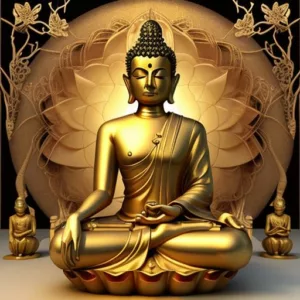
Dharma means 2 things: Buddhist doctrine (Dharma) and phenomena (dharma). It is the 2nd of the 3 jewels of Buddhism. Dharma fundamentally means – how things work and how to conduct oneself in that system to attain happiness.
The symbol is the Tibetan letter AH. It represents speech. It can be drawn to represent the speech of the Buddha. This would be dhamma essentially by definition. At least, the recorded speech of the Buddha. The letter represents dharma altogether.
The dharma is my favorite of the 3 jewels. I’m a bit of a hermit, so the sangha is hard to meet and connect with. But I like them for the most part. Most teachers are great, too. But the dhamma finds a special place in my life because it’s the explanation for how to do things. It’s always available, even when the human teacher and the sangha are not.
When I return it will be in the form of texts.
Buddha
Table of Contents
Secrets of Meditation for Anxiety
Like millions of people, you may have suffered from anxiety for years. Meditation, yoga, peaceful music – it never works. It takes too long, and it’s not stable. Why? Because peace is treated as a cause for freedom, but it’s not – it’s the result. The cause to free yourself from anxiety is completely different.
Click now to Overcome Anxiety for good.
Dharma Summary
| Concept | Description |
|---|---|
| Dharma (Sanskrit) | A complex and multifaceted concept in Indian religions, particularly Hinduism, Buddhism, and Jainism. |
| chö | Tibetan terms for Dhamma |
| Buddhism | * Universal truth or law underlying reality. * The teachings of the Buddha, leading to enlightenment. * Three Jewels: Buddha, dhamma, Sangha. |
| Hinduism | * Duty, law, right conduct, good morals. * Fulfilling one’s role and responsibilities according to caste and social status. * Path to achieving liberation (Moksha). |
| Jainism | * The teachings of the Jinas (enlightened beings). * The path to liberation from the cycle of rebirth. |
| Key Meanings | * Law and Order: Dhamma can represent the cosmic order and natural laws that govern the universe. * Duty and Righteousness: Fulfilling one’s Dhamma involves following moral principles and acting in accordance with one’s role in society. * Path to Liberation: Following Dhamma is seen as a path towards achieving spiritual liberation or enlightenment. * Teachings: In Buddhism, Dharma refers specifically to the teachings of the Buddha. |
| Related Concepts | * Karma (Sanskrit): The law of cause and effect. Actions (good or bad) have consequences. Fulfilling one’s Dharma can lead to positive karmic results. |
Related Terms for Dharma
Dharma Related Terms
Core Concepts:
- Hinduism
- Buddhism
- Jainism
- Righteousness
- Morality
- Duty
- Liberation (Moksha)
- Enlightenment
- Universal Truth
- Cosmic Law
- Spiritual Path
Practices:
- Fulfilling social obligations
- Following moral precepts
- Meditation
- Non-violence (ahimsa)
- Right livelihood
Benefits:
- Spiritual progress
- Liberation from suffering
- Positive karma
- Inner peace
- Harmony with the universe
Related Concepts:
- Karma
- Samsara (cycle of rebirth)
- Nirvana (Buddhist liberation)
- Moksha (Hindu liberation)
- Ahimsa (non-violence)
- Right action
- Right speech
- Right livelihood
- Right mindfulness
- Right concentration (Eightfold Path)
Additional Terms:
- Buddha
- Jina
- Vedas (Hindu scriptures)
- Pali Canon (Buddhist scriptures)
- Jain Agamas (Jain scriptures)
- Ashrams (Hindu spiritual centers)
- Viharas (Buddhist monasteries)
Key Points of Dharma
Dharma is a core idea in many traditions, especially Buddhism. It’s a difficult word to translate. I personally prefer TRUTH, but also duty, virtue, or order can be used. It was originally used in Hinduism to mean a life that accords with one’s karma or place in the universe. That which makes the flow of life possible. It has a sense of a cosmic law.
The Buddha used the word for his system. In classical Sanskrit, it means the support of the universal way of being. It also means to remain firm and solid. Thus, it is law, not as in the law of humanity, but as in the law that cannot be broken.
Mostly in Buddhism, dharma means the doctrinal teachings of the Buddha, that which accords with reality. In pure Buddhism, Dharma means the cultivation of the eightfold path of right thought, action, and so forth.
trangdön and ngedön, relative and ultimate dhamma
The Buddha’s teaching includes what are called trangdön or the provisional teachings, the teachings which point the way. These are meant to guide the student towards the ultimate truth and towards realization. The ngedön is meant to point out the genuine truth itself. It is not provisional, it is ultimate. It is the final answer to the problem: what is reality?
The means to approach Dharma so that realization can happen is both the eightfold path and the method of hearing, contemplating, and meditating. First, one listens to or reads Dharma texts – that’s hearing. Contemplating means to turn it over in your mind, to make it your own, to deepen your understanding, to make it real, to fill in the gaps, and to know what the nuances are.
Meditating is to take that conceptual understanding and apply it in meditation. This will depend on what the particular understanding is. If it’s the karmic chain of nadonas, one would try to penetrate the karmic chain at one of the links that can be broken through meditation, for example. There are many other methods that apply.
I find the ngedön very simple, in a sense, but difficult to perceive. That’s kind of the idea. We have so many obscurations, that we need the trangdön in order to approach the ngedön obliquely. We have to close in on it conceptually before we can see it directly. It’s like looking for someone in a crowd that’s only been described to us. The better the description, the more likely we will be to spot them.
Dhamma Overview
Dharma, a concept both profound and multifaceted, holds a central place in various Indian religions, especially Hinduism, Buddhism, and Jainism. But what exactly does it encompass? Let’s delve into its essence:
- Dhamma Meaning: The term translates to “duty,” “law,” “right conduct,” or “morality.” It signifies fulfilling one’s role and responsibilities while adhering to ethical principles.
- Dharma Definition: Understanding it can be like grasping a multifaceted gem. Depending on the context, it refers to the universal truth or law underlying reality (Buddhism), the path to liberation (Moksha) in Hinduism, or even fulfilling one’s social obligations based on caste and social status.
- Dharma English Meaning: In English, it is often translated as “duty” or “righteous path,” highlighting the emphasis on ethical conduct.
- dhamma Meaning in Hindi: In Hindi, it translates to “धर्म” (pronounced as dhar-muh) and carries the same core meaning of duty, righteousness, and ethical conduct.
- Dhamma (pali) has no written form. Typically the Sinhala script is used – ධම්ම.
Dhamma Across Religions: Hinduism, Buddhism
- Dharma Hinduism (Dhamma Hindu, Dhamma in Hinduism): In Hinduism, Dhamma signifies fulfilling one’s duties and responsibilities according to social status and following moral principles. It’s also considered the path towards achieving liberation (Moksha).
- Dharma Buddhism (Dharma Buddhism Definition): Within Buddhism, Dhamma refers to the universal truth or law that underlies reality. It also encompasses the teachings of the Buddha, which guide individuals towards enlightenment. Dhamma is considered one of the Three Jewels of Buddhism, alongside the Buddha and the Sangha (monastic community).
- Dharma Religion (Dhamma vs Religion): While Dhamma is a core concept in Hinduism, Buddhism, and Jainism, it’s not necessarily a religion itself. It represents a fundamental principle that can be found within these religions. However, some might argue that following Dhamma can be seen as a religious practice in itself.
- Dharma in Sanskrit: The word originates from the Sanskrit language, where it holds the same core meaning of duty, law, and right conduct.
Sanātana Dharma Meaning
Sanātana Dharma (Sanskrit: सनातन धर्म, pronounced suh-naa-tuh-na dhamma) is an alternative name for Hinduism, particularly when referring to it as a unified world religion. Here’s a breakdown of the term:
- Sanātana (सनातन): This translates to “eternal,” “perennial,” or “unchanging.”
- dhamma (धर्म): As we already know, dhamma refers to “duty,” “law,” “right conduct,” or “morality.” It also carries meanings like the universal truth, the path to liberation, or following one’s social obligations.
So, Sanātana dhamma literally translates to “eternal dhamma” or “eternal law.”
Here’s how Sanātana dhamma is used:
- Alternative Name for Hinduism: It’s used alongside the more common term “Hindu dhamma” to emphasize the enduring and universal nature of Hinduism’s core principles.
- Highlighting Timeless Values: The term Sanātana dhamma emphasizes the idea that Hinduism’s core values and teachings transcend historical boundaries and remain relevant in any age.
- Non-Sectarian Approach: Some use Sanātana dhamma to refer to Hinduism as a broad religious tradition encompassing various schools of thought and practices.
It’s important to note that not all Hindus necessarily use the term Sanātana dhamma. Some might prefer the more specific term “Hindu dhamma” to identify with their particular tradition within Hinduism.
Dharma Practices and Teachers
- Dharma Seed: Online meditation organization offering free recordings of talks.
- dhamma Law: The law refers to the principles and ethical guidelines that govern living a righteous life.
- dhamma Teacher (Rinpoche, Guru, Lama): A teacher is a spiritual guide who provides instruction and guidance on the path, guru or lama.
- dhamma Teachings: These are the teachings and wisdom passed down by enlightened beings or teachers related to living a life aligned with virtue.
- dhamma Practices (including dhamma Meditation): practices encompass various methods and techniques, including meditation, to cultivate mindfulness, compassion, and ethical conduct in accordance with good principles.
- dhamma Body (dharmakaya): The concept of the Dhamma body can have different interpretations. In some traditions, it refers to the enlightened essence of a Buddha, while in others, it signifies the universal truth or reality itself.
- dhamma Eye: The eye symbolizes wisdom and insight gained through the practice, allowing one to see the true nature of reality.
- 5 Types of dhamma: Sovereign, worldly, individual, seed, and resultant.
Dhamma Symbolism
- Dharma Chakra: The Dharmachakra, also known as the dhamma wheel, is a widely recognized symbol representing dhamma. It typically features eight spokes, signifying the Eightfold Path, a core Buddhist concept leading to enlightenment. The Dharmachakra is found in both Buddhist and Hindu traditions, although the interpretations might differ slightly.
Additional Symbolic Representations (depending on your content):
While the wheel of truth is the most prominent symbol, you might also explore other potential representations depending on the focus of your post. Here are a few examples:
- dhamma Ocean: The vastness and depth of dhamma could be metaphorically represented by an ocean. A recurring name for realized teachers. Chokyi Gyatso. An organization dedicated to the teachings of the 11th Trungpa Tulku.
- Deer: Symbolic of first dhamma teaching given by the Buddha at Deer Park.
Dharma Errata
- Dharma Initiative (Pop Culture Reference): The dhamma Initiative is a fictional research project featured in the television series Lost. While not directly related to the religious concept, it highlights the intriguing ways “dhamma” can be used in popular culture.
- dhamma Recovery (Modern Usage): a 12-step program that incorporates Buddhist principles like mindfulness and ethical conduct to help individuals overcome addiction.
- Dharma Yoga Meaning (Specific Type of Yoga): a style of yoga that emphasizes alignment, breathwork, and ethical principles, drawing inspiration from the concept of dhamma.
- Dharma Pronunciation: The pronunciation of dharma can vary slightly depending on the language. In Sanskrit, it’s pronounced “dhar-muh,” while in Hindi, it’s closer to “dhur-muh.”
- Dhamma Examples: Illustrative examples can help solidify the understanding of dhamma. These could involve stories, historical figures, or situations where individuals uphold dhamma in their actions.
- Dharma in a Sentence: Here are some examples of how “dhamma” can be used in a sentence: “Living according to dhamma means acting with compassion and integrity.” “The Buddha’s teachings emphasize the importance of following the dhamma.”
- Dharma Quotes in Hindi (Specific Language): Exploring dhamma quotes in Hindi can offer a deeper understanding of the concept within that specific cultural context.
- Dharma Quotes in Sanskrit (Specific Language): Similarly, Sanskrit dhamma quotes can provide insights into the original language source.
- Dharma and Dhamma (Comparison): “dhamma” and “dhamma” are closely related terms. Dhamma is the Pali language equivalent of dhamma, and both concepts share the same core meaning.
- dhamma Videos.
- Dharma Explained.
- Dharma Gates: The three gates are Body, Speech, and Mind.

May all beings be happy
May all beings be peaceful
May all beings be safe
May all beings awaken to the light of their true nature
May all beings be free








Test.